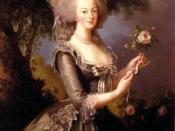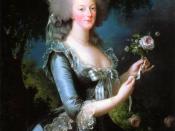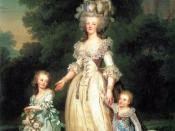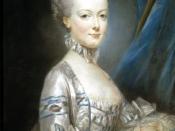ÃÂMarie Antoinette Joséphe Jeanne de Habsbourg-Lorraine was born at the Hofburg Palace in Vienna on 2nd November 1755 and died in Paris on 16th October 1793. She was the Archduchess Maria Antonia and the youngest daughter of Maria Theresa and Francis I, the Empress and Emperor of the Holy Roman Empire, of Austria. She had a complex childhood, her parents, leading one of the strongest Empires in Europe, lived a formal public life. Her private life was similar to the life she later recreated in the Petit Trianon at Versailles, a life where the family dressed in plain cotton clothes, in comparison to the bourgeoisie, and the children socialised with the ÃÂnormalànon-royal children in a carefree and tranquil lifestyle. This alternative royal lifestyle idea, that the Emperor and Empress had produced, was closely linked to the changes they made in court. Her parents had changed long standing traditions of court etiquette and that most definitely influenced the identical actions Marie Antoinette initiated in the French royal court.
These actions received much dispute and discontent amongst the older generation in the French court. Marie Antoinette was unfortunate in her Austrian education, for the court she had grown up in was exceptionally unresponsive to intellectual interests, and so she was brought up with little culture. Marie Theresa confirmed that she neglected her daughter, as Marie Antoinette was not a good letter writer and was not interested in literature. Maria Theresa was said to be a woman of resolution and great skill, however, Marie Antoinette possessed little of this and she was said to be vain and frivolous. This was shown in many affairs of State where she would always take the individual view, never the statesmanÃÂs viewpoint. Because of this, her interference in the government was often useless and detrimental. However, some of the noble qualities of her strong mother, were portrayed in the latter end of her life, these were courage and devotion.
She married Louis XVI of France at the age of 14 and became the Dauphine de France. She became Queen of France at the age of 19 in June 1774 following the death of King Louis XV in May 1774. She gave birth to four children, one of whom died a short while after birth. The marriage was intended to reinforce the alliance between France and Austria. This forced marriage was unsuited for Marie Antoinette. The Austrian alliance represented by her, was considered unpopular both as a departure from French tradition and as the reason for many misfortunes of France. From her initial arrival, there was automatic grudge and suspicion, mainly because she was not French. From the beginning, she was unhappy in the marriage and she was disliked by the French people, this led her to make excessive expenditure, which was the foundation for the French Revolution. Marie Antoinette had extreme power and influence over the king and because of this Louis XVI made many unintelligent political decisions that were detrimental to the monarchy and France. This created more hatred towards Marie Antoinette from the suffering bourgeoisie. Marie Antoinette was a fickle and shallow woman and she did nothing to offset the kingÃÂs weaknesses. Her careless behaviour resulted in her having many enemies. This behaviour gave them opportunities for campaigns against her, which fed the public more reasons to hate her and the monarchy. She was seen as an easy target, because she was Austrian, young naïve and because of her heritage and extravagance, it was easy to put the blame on her for the downfall of FranceÃÂs financial crisis. Marie Antoinette was nicknamed Madame Déficit, as she was blamed for single-handedly ruining the financial situation of France. This was later changed to ÃÂlÃÂAutrichenneÃÂ, the ÃÂAustrianÃÂ. As her unpopularity increased, this changed to ÃÂlÃÂAutruchienneÃÂ, a pun using the words autruche meaning ÃÂostrichàand chienne meaning ÃÂbitchÃÂ. She was accused of destroying long standing political traditions and laughing at older womenÃÂs influence at court. She later informed her friends that she intended on having no further involvement in French politics, although this may or may no have been followed through by her. However, she feared repercussions if she was to be further involved.
One of the primary causes for the public hating Marie Antoinette was because of her excessive and mindless spending. France was already in intense debt from previous wars, for example, The Seven Years War. Louis XVI and Marie Antoinette going into monarchy so young played a large factor to the French Revolution; they were young and incompetent with no knowledge of financial control. As previously mentioned, Marie Antoinette was extremely unhappy, she was married to a man whom she didnÃÂt love and she was in a country where she was not welcome. To make matters worse, the pressure from the court, her mother and the country to produce a male heir was tying her down. The relationship between king and queen was not a close one, therefore a reason for taking seven years to produce a child. In these seven years, Marie Antoinette would constantly write to her mother, Maria Theresa, who would say in her letters that her daughter had lost her beauty and elegance therefore the reason for not being able to produce an heir. Marie Antoinette was said to say that she was more terrified of her mother than how much she loved her. This poor relationship with her mother and the lack of love and affection from Louis, led Marie Antoinette to more unhappiness, therefore spending even larger amounts of money on items of clothing, jewellery, shoes, gambling and parties. Marie Antoinette received great criticism from the people of France for the renovation of the Petit Trianon and for building of the Hameau (Hamlet) at Versailles, where she was said to have played milk-maid in parklands and rustic cottages. This is where she retreated from court life and relaxed as she had done in her upbringing in the Hofburg palace in Vienna. She also bought the Château de Saint-Cloud, which she claimed to have bought to leave to her children as an inheritance. This was one of many scandals about the queen, it outraged the people of France as it was estimated to have cost approximately 6 million livres not considering the redecorating costs. Events like these contributed greatly to her large unpopularity throughout France, along with the famous saying ÃÂlet them eat cakeàwhich has caused much speculation to whether she in fact did say this or not, many believe it as a myth. A constant publication of the libelles, a magazine outlining court affairs, focused on the scandals of the monarchy, primarily Marie Antoinette. Many assemblies were held to aid the financial crisis and plans to cutback on court expenditure, Marie AntoinetteÃÂs absence caused, once more, speculation of attempting to undermine the purpose of the assembly and FranceÃÂs crisis. Marie Antoinette was portrayed much worse in the public eye than she really was, this created more dislike towards her and she became unhappy and this led to even more excessive expenditure and hence a vicious circle. She was seen as disrespectful, uncaring and her behaviour was considered totally inappropriate in a time where people were dying and starving in the streets. She was being accused of orgies in Versailles, sending money to Austria, sexual favours to an entire Guards regiment in one night, incest with her son, plotting to kill the duc dÃÂOrléans, assisting in the massacre of the Swiss Guards in 1792 and declaring her son to be the new king of France. The Diamond Necklace Affair of 1784 was a major scandal concerning Marie Antoinette. In this scandal she was accused of contracting venereal disease from the cardinal de Rohan and spreading it throughout the court. It isnÃÂt certain whether this scandal is true or not, but many people were willing to believe it, for any excuse to dislike the queen and the monarchy even more. There were more rumours speculating about her seeking sexual encounters elsewhere because Louis was so preoccupied with his hobbies, politics and impotence, this was also released in the libelles. The queen was being portrayed more wicked by the day. She had her own propaganda attempting to fight back, portraying herself as a caring mother with various portraits painted of her with her children. Sadly, this was dropped as her youngest daughter, Sophie, died. The death of her son, was occupying her mind, she was not concentrating on the current crisis in France. When her son died, instead of being nationally mourned, as normal, it was ignored by the people of France. They were concentrating on preparing for the next Estates General meeting regarding the bread prices.
The main reason why Louis XVI and Marie Antoinette were guillotined was the fact that they attempted to escape France and seek help elsewhere, possibly Austria. This idea was predominantly Marie AntoinetteÃÂs, she, and other courtiers, persuaded Louis to leave Paris where he was staying. They were caught and brought back on accusations that they were escaping and seeking help and not facing up to the problem and trying to solve it by themselves. On their return to Paris, she was threatened to be butchered and eaten and guns were fired over her head. She was paid much less respect than Louis XVI as he was truly French and she was just ÃÂlÃÂAutrichenneÃÂ.
Marie Antoinette was charged of instigating orgies in Versailles, plotting to kill the duc dÃÂOrléans, incest with her son, sending copious amounts of money to Austria, instigating the massacre of the Swiss Guards in 1792 and declaring her son to be the new king of France, most of these were untrue. She was sent to trial and was executed on 16 October 1789.
Word Count: 1, 622BibliographyÃÂMatthews, Andrew (2001), Revolution and Reaction: Europe 1789-1849, Cambridge University Press, Cambridge, UK.
ÃÂActon, Lord (1969), The Cambridge Modern History: VIII. The French Revolution, Cambridge University Press, Cambridge, UK.
ÃÂCronin, Vincent (1974), Louis and Antoinette, William Collins Sons & Co. Ltd, Glasgow.
ÃÂCole, Robert (2001), A TravellerÃÂs History of France, Interlink Books, Canada.
ÃÂWetterau, Bruce (1994), World History, Robert Hale, London.
ÃÂLanger, William L. (1968), An Encyclopedia of World History, George G. Harrap & Co. Ltd, London.
ÃÂWright, E & Tumelty, J.J. (1967), An Age of Revolution, The Hamlyn Publishing Group Ltd, France.
ÃÂVarious (1968), The Last Two Million Years, ReaderÃÂs Digest, Surry Hills.





